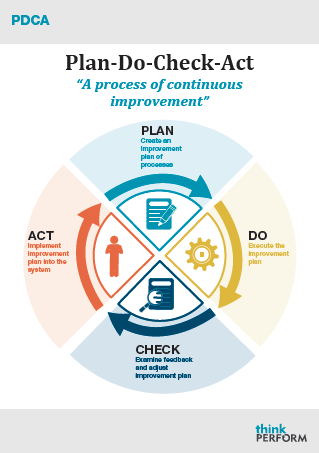The Continuous Improvement Process & Organisational Success
Many companies today are engaged in what is known as a Continuous improvement process. This is simply a continuing attempt to reliably enhance an organisation’s profitability, efficiency and productivity by using a proven process known as the PDCA cycle. PDCA is an acronym that stands for plan, do, check and act. What is the continuous improvement process? Continuous improvement systems and processes are strategies designed to slowly shape a company, corporation, or non-profit to the point it enjoys heightened production for less effort and a greater profit margin.

What is a Continuous Improvement Cycle?
A continuous improvement cycle is known by a variety of names, such as design, implementation and evaluation, or strategy, application and measurement. Regardless of title, it is a popular and respected means for improving organisational processes, services and products. Its results are small, specific, cumulative, and surprisingly powerful. They occur in intentional cycles, which provide those in authority with time to evaluate and refine strategy as they go along. Studies have determined that an ongoing improvement process is one of the most successful means by which an organisation can achieve its long-term goals.
What Constitutes a Continual Improvement Plan?
There are typically four or more steps to a successful continuous improvement plan. Generally speaking, core elements begin with a straightforward strategy or plan, which is then implemented. When a predetermined amount of time has passed, the process is halted and the results are studied and evaluated. Depending upon the outcome, the plan is tweaked and once again put into play. Regardless of the specific type of organisational structure, a quality improvement plan results in a company that incrementally conforms itself to whatever constraints are necessary for the entity to be as profitable as possible.
How is Continuous Improvement Strategy Success Assessed?
The success of a strategy is most frequently determined by company profits. Occasionally, as in the case of not-for-profits or civic organisations, it is measured by the attainment of other measurable goals, such as efficiency, the number of contacts made, processed or converted, and similar measures. Continuous improvement processes are commonly structured to include parameters such as quality, safety, and retention. Whenever a product, service, or other attributes measurably increase beyond their baseline recording, it is statistically perceived as a success. Factors like loss reduction, client satisfaction and identification of waste are analysed when determining goals for organisational change. By comparing these types of statistics to baseline measurements, an organisation’s improvements are able to be statistically measured.
Are There Specific Characteristics of Successful Improvement Processes?
Continuous process improvement is a type of perpetual loop. It moves from planning, to implementation, to evaluation, to revision, and then back to planning, reissue and on again. It is precise and methodical. One of its key benefits is that it does not allow for organisational stagnation. Factors such as perceived vulnerabilities, areas earmarked for improvement, employee participation, and client satisfaction are monitored, measured, and manipulated to orchestrate improvement. Many organisations have noted greater levels of improvement when employees who will be impacted by the changes under consideration are included in the planning and evaluation stages of the process.
Nearly all organisations share similar goals, even when their by-products are distinctly dissimilar. Continuous improvement processes work in concert with diverse objectives such as corporate ambitions, educational aspirations, and charitable endeavours alike. The ability to qualitatively and quantitatively document measurements of characteristics like achievement, retention, loss, communication, cooperation and so forth is one that definitely sets an enterprise apart from its competition. Likewise, being able to accurately pinpoint the precise ways in which an entity stands to benefit from change is a means of providing investors, employees, and consumers alike with the assurance this organisation is one that is more than able to adapt to whatever challenges the future might bring.

